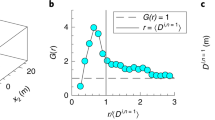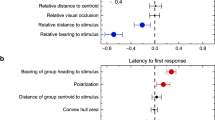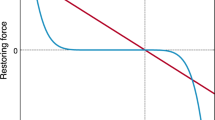Abstract
Collective decision-making in biological systems requires all individuals in the group to go through a behavioural change of state. During this transition fast and robust transfer of information is essential to prevent cohesion loss. The mechanism by which natural groups achieve such robustness, however, is not clear. Here we present an experimental study of starling flocks performing collective turns. We find that information about direction changes propagates across the flock with a linear dispersion law and negligible attenuation, hence minimizing group decoherence. These results contrast starkly with present models of collective motion, which predict diffusive transport of information. Building on spontaneous symmetry breaking and conservation-law arguments, we formulate a theory that correctly reproduces linear and undamped propagation. Essential to this framework is the inclusion of the birds’ behavioural inertia. The theory not only explains the data, but also predicts that information transfer must be faster the stronger the group’s orientational order, a prediction accurately verified by the data. Our results suggest that swift decision-making may be the adaptive drive for the strong behavioural polarization observed in many living groups.
This is a preview of subscription content, access via your institution
Access options
Subscribe to this journal
Receive 12 print issues and online access
$209.00 per year
only $17.42 per issue
Buy this article
- Purchase on Springer Link
- Instant access to full article PDF
Prices may be subject to local taxes which are calculated during checkout



Similar content being viewed by others
References
Conradt, L. & Roper, T. J. Consensus decision making in animals. Trends Ecol. Evol. 20, 449–456 (2005).
Conradt, L. & List, C. Group decisions in humans and animals: A survey. Phil. Trans. R. Soc. B 364, 719–742 (2009).
Parrish, J. K. & Hamner, W. H. (eds) Animal Groups in Three Dimensions (Cambridge Univ. Press, 1997).
Krause, J. & Ruxton, G. D. Living in Groups (Oxford Univ. Press, 2002).
Couzin, I. D. & Krause, J. Self-organization and collective behavior in vertebrates. Adv. Study Behav. 32, 1–75 (2003).
Sumpter, D., Buhl, J., Biro, D. & Couzin, I. Information transfer in moving animal groups. Theory Biosci. 127, 177–186 (2008).
Bajec, I. L. & Heppner, F. H. Organized flight in birds. Anim. Behav. 78, 777–789 (2009).
Nagy, M., Akos, Z., Biro, D. & Vicsek, T. Hierarchical group dynamics in pigeon flocks. Nature 464, 890–894 (2010).
Pomeroy, H. & Heppner, F. Structure of turning in airborne Rock Dove (Columba livia) flocks. Auk 109, 256–267 (1992).
Cavagna, A. et al. The STARFLAG handbook on collective animal behaviour: 1. Empirical methods. Anim. Behav. 76, 217–236 (2008).
Radakov, D. V. Schooling and Ecology of Fish (John Wiley, 1973).
Toner, J. & Tu, Y. Flocks, herds, and schools: A quantitative theory of flocking. Phys. Rev. E 58, 4828–4858 (1998).
Huth, A. & Wissel, C. The simulation of the movement of fish schools. J. Theor. Biol. 156, 365–385 (1992).
Vicsek, T., Czirók, A., Ben-Jacob, E., Cohen, I. & Shochet, O. Novel type of phase transition in a system of self-driven particles. Phys. Rev. Lett. 75, 1226–1229 (1995).
Couzin, I. D., Krause, J., James, R., Ruxton, G. D. & Franks, N. R. Collective memory and spatial sorting in animal groups. J. Theor. Biol. 218, 1–11 (2002).
Grégoire, G. & Chaté, H. Onset of collective and cohesive motion. Phys. Rev. Lett. 92, 025702 (2004).
Bialek, W. et al. Statistical mechanics for natural flocks of birds. Proc. Natl Acad. Sci. USA 109, 4786–4791 (2012).
Ballerini, M. et al. Interaction ruling animal collective behavior depends on topological rather than metric distance: Evidence from a field study. Proc. Natl Acad. Sci. USA 105, 1232–1237 (2008).
Ginelli, F. & Chaté, H. Relevance of metric-free interactions in flocking phenomena. Phys. Rev. Lett. 105, 168103 (2010).
Ryder, L. H. Quantum Field Theory (Cambridge Univ. Press, 1985).
Halperin, B. I. & Hohenberg, P. C. Hydrodynamic theory of spin waves. Phys. Rev. 188, 898–918 (1969).
Ballerini, M. et al. Empirical investigation of starling flocks: A benchmark study in collective animal behaviour. Anim. Behav. 76, 201–215 (2008).
Nambu, Y. Quasiparticles and gauge invariance in the theory of superconductivity. Phys. Rev. 117, 64–663 (1960).
Goldstone, J. Field theories with superconductor solutions. Nuovo Cimento 19, 154–164 (1961).
Cavagna, A et al. Scale-free correlations in starling flocks. Proc. Natl Acad. Sci. USA 107, 11865–11870 (2010).
Hohenberg, P. C. & Halperin, B. I. Theory of dynamic critical phenomena. Rev. Mod. Phys. 49, 435–479 (1977).
Matsubara, T. & Matsuda, H. A lattice model of liquid helium, I. Prog. Theor. Phys. 16, 569–582 (1956).
Sonin, E. B. Spin currents and spin superfluidity. Adv. Phys. 59, 181–255 (2010).
Justh, E. W. & Krishnaprasad, P. S. Equilibria and steering laws for planar formations. Syst. Control Lett. 52, 25–38 (2004).
Szabo, P., Nagy, M. & Vicsek, T. Transitions in a self-propelled-particles model with coupling of accelerations. Phys. Rev. E 79, 021908 (2009).
Hemelrijk, C. K. & Hildenbrandt, H. Some causes of the variable shape of flocks of birds. PLoS ONE 6, e22479 (2011).
Gautrais, J. et al. Deciphering interactions in moving animal groups. PLoS Comput. Biol. 8, e1002678 (2012).
Simha, R. A. & Ramaswamy, S. Hydrodynamics fluctuations and instabilities in ordered suspensions of self-propelled particles. Phys. Rev. Lett. 89, 058101 (2002).
Hartley, R. & Zisserman, A. Multiple View Geometry in Computer Vision (Cambridge Univ. Press, 2003).
Attanasi, A. et al. Tracking in three dimensions via recursive multi-path branching. Preprint at http://arxiv.org/abs/1305.1495 (2013).
CPLEX Optimization Incorporated, Using the CPLEX Callable Library (Incline Village, 1994).
Conner, G. R. & Christopher, P. G. An extension of Zermelo’s model for ranking by paired comparisons. Eur. J. Appl. Math. 11, 225–247 (2000).
Acknowledgements
We thank J.G. Lorenzana for bringing Model F to our attention. We thank E. Cappelluti, C. Castellani, G.A. Cavagna, M. Cencini, F. Cecconi, F. Ginelli, S. Ramaswamy and J. Toner for discussions, and P. Calabrese and D. Levine for reading the manuscript. We also acknowledge the advice of C. Lucibello on tracking and the help of E. Silvestri on segmentation and on testing our tracking algorithm against synthetic data. This work was supported by grants IIT–Seed Artswarm, ERC–StG no. 257126 and US-AFOSR FA95501010250 (through the University of Maryland).
Author information
Authors and Affiliations
Contributions
A.C. and I.G. designed the study. A.C. coordinated the experiment. A.A., A.C., I.G., S.M., L.P., E.S. and M.V. set up and calibrated the 3D system. L.D.C., S.M., O.P. and E.S. performed the experiment. A.A., A.C., L.P. and M.V. developed the tracking method. A.A., S.M., L.D.C., E.S. and M.V. tested the tracking method and produced the 3D data. A.J. analysed the data. A.C., I.G., T.S.G. and A.J. formulated the theory. A.C. wrote the paper.
Corresponding authors
Ethics declarations
Competing interests
The authors declare no competing financial interests.
Supplementary information
Supplementary Information
Supplementary Information (PDF 1134 kb)
Supplementary Movie
Supplementary Movie 1 (MOV 1632 kb)
Supplementary Movie
Supplementary Movie 2 (MOV 4728 kb)
Rights and permissions
About this article
Cite this article
Attanasi, A., Cavagna, A., Del Castello, L. et al. Information transfer and behavioural inertia in starling flocks. Nature Phys 10, 691–696 (2014). https://doi.org/10.1038/nphys3035
Received:
Accepted:
Published:
Issue Date:
DOI: https://doi.org/10.1038/nphys3035
This article is cited by
-
Spontaneous vortex formation by microswimmers with retarded attractions
Nature Communications (2023)
-
Natural swarms in 3.99 dimensions
Nature Physics (2023)
-
Characterization of lab-based swarms of Anopheles gambiae mosquitoes using 3D-video tracking
Scientific Reports (2023)
-
Transition from simple to complex contagion in collective decision-making
Nature Communications (2022)
-
Marginal speed confinement resolves the conflict between correlation and control in collective behaviour
Nature Communications (2022)



